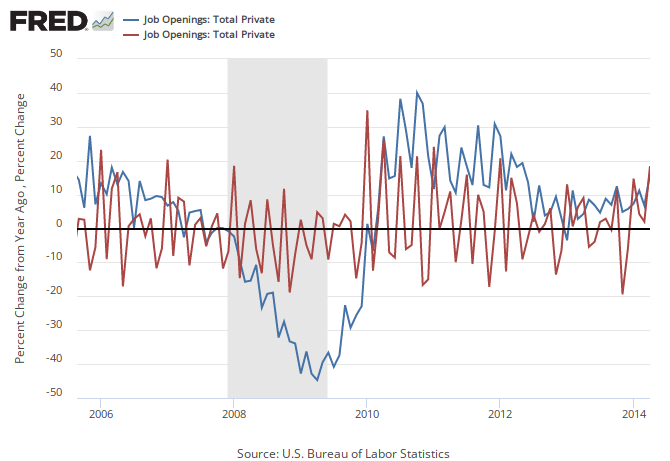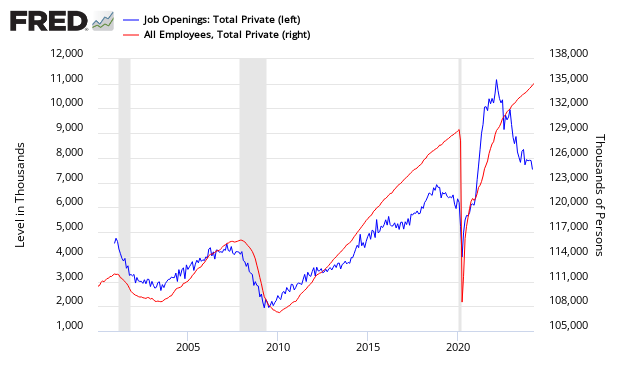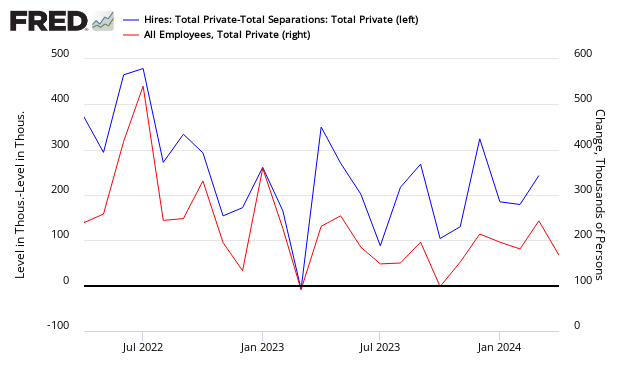JOLTS Continues To Predict Elevated Jobs Growth
The BLS Job Openings and Labor Turnover Survey (JOLTS) can be used as a predictor of future jobs growth, and the predictive elements show that the private non-farm job opening growth rate declined slightly. However, the current rate is quite high - so the high employment growth currently being seen should continue.

- the number of unadjusted PRIVATE jobs openings – which is the most predictive of the JOLTS elements – the year-over-year growth rate declined from originally released 24.9% (August) to 20.5% (September). The unadjusted non-farm private jobs opening rate (percent of job openings compared to size of workforce) declined slightly from 3.7% to 3.5%. Overall, the data is predicting relatively stable employment growth at the current levels - as the data remains slightly above the average for 2014 even though it moderately declined this month.
Unadjusted Private Jobs Openings from JOLTS - Year-over-Year (blue line) compared to Change from Last Month (red line)

- The market expected seasonally adjusted jobs openings at 4.655 million to 4.850 million (consensus 4.800 M) versus the headline 4.735 million.
The relevance of JOLTS to future employment is obvious from the graphic below which shows JOLTS Job Openings leading or coincident to private non-farm employment. JOLTS job openings are a good predictor of jobs growth turning points.
Seasonally Adjusted Private Jobs Openings from JOLTS (blue line, left axis) compared to BLS Non-farm Private (red line, right axis)

The graph below uses year-over year growth comparisons of non-seasonally adjusted non-farm private BLS data versus JOLTS Job Openings – and then compare trend lines. JOLTS is showing a long term trend improvement - even with the decline this month.
Year-over-Year Change – Seasonally Jobs Openings from JOLTS (blue line, left axis) compared to Unadjusted BLS Non-farm Private (red line, right axis)

- The JOLTS Unadjusted Private hires rate (percent of hires compared to size of workforce) rose from 4.0 to 4.1 – and the separations rate (percent of separations compared to size of workforce) declined from 4.3 to 4.1 . Separations are the workforce which quit or was laid off. Likewise, hires are the workforce hired. This portion of JOLTS is not predictive.
Seasonally Adjusted Hires (blue line) and Seasonally Adjusted Separation Levels (red line) – Non-Farm Private

However, please note that Econintersect has not been able use the hire rate or the separation rate (or a combination thereof) to help in understanding future jobs growth. A Philly Fed study agrees with Econintersect’s assessment. JOLTS is issued a month later than the jobs data – and correlates against one month old data. The data in the below chart shows that the JOLTS data is turning at the same points – but the JOLTS data is released one month later making this a lagging indicator.
Hires less Separation Rate (blue line, left axis) compared to Non-Farm Private BLS Non-farm Private (red line, right axis)

Caveats on the Use of JOLTS
This data series historically is very noisy which likely is a result of data gathering issues and/or seasonal adjustments. Therefore this series must be trended to provide any understanding of the dynamics. One of two months of good or bad data are not predictive.
Disclosure: None.



